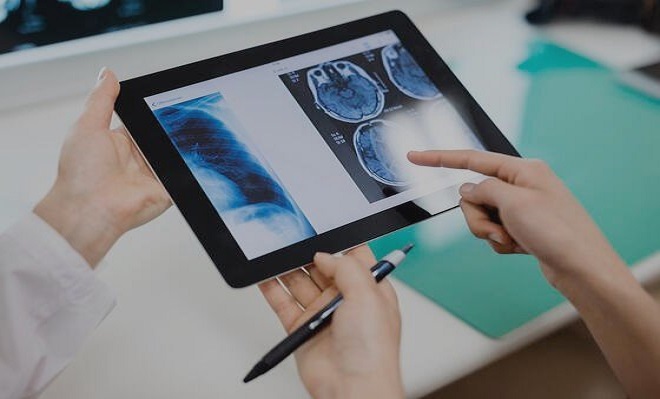Table of Contents
The sufferings of humankind are immense and the struggle to find relief from them has led to discoveries that have challenged human existence. Technological advancements have tried to hack the human brain, body, mind to understand and predict human behavior. It’s unimaginable how world chess champion Gary Kasparov was defeated by an IBM supercomputer called Deep Blue. Humans might not have predicted that technology would checkmate them. But it did. All said and done technology is a double-edged sword. One cannot deny that technological advancements find their source in the human mind and imagination.
We have progressed in the field of healthcare to find solutions to challenging situations and diseases. Teleradiology is one such solution that has overcome the challenge of time and space. Let’s say a critically ill patient requires an urgent diagnosis and the doctor needs an immediate interpretation of the CT scan or MRI. The radiologist isn’t available at that time. What could be done and how technology could provide a solution?
Teleradiology initiates a process where the CT scan or MRI is sent to a teleradiologist based in some other hospital/center (maybe in some other geographical region- city or country) through the internet and he/she interprets the report, which is immediately sent back to the doctor or patient. The result is a quick diagnosis and timely treatment working as a boon to the patient’s life.
Geographical barriers have faded with the invention of the internet and no one could have imagined that it would benefit innumerable patients and assist healthcare professionals.
Today, we delve a bit deeper into how teleradiology has further changed our lives.
How teleradiology has been a boon to healthcare?
Benefits to remote areas in India:
Why is teleradiology a boon?
Indian healthcare challenges are unique. Contrast is evident where at one end plush hospitals in cities give quick access to urbanites while health centers in rural areas lag behind significantly in providing even the primary healthcare facilities. We are referring to the remotest areas in India. In rural areas Primary Health Care centers are limited. Also in some areas, the healthcare facilities cannot be reached within 5 km.
Though we see hope with the implementation of the National (Rural) Health Mission that has helped to improve infrastructure in the Indian Government healthcare system. Technology-enabled rural virtual healthcare is spearheading access to healthcare in these remote areas.
According to the Future Health Index 2021 report India witnesses a shift of priority to improving remote care and adopting digital technologies.
Teleradiology is providing the much-needed support to this shift. When the radiology reports need to be interpreted and a radiologist is not available at the hospital/healthcare center, the report is sent to a teleradiologist in urban areas via the internet. A detailed interpretation is done by a teleradiologist and sent back to the hospital in the rural area. It’s true these areas face internet connectivity issues but it’s just a matter of time that Indians living in remote areas will soon experience better internet connectivity. Soon rural populations will start benefiting more from telehealth and teleradiology as internet service providers shift their focus to rural areas.
How teleradiology has helped people around the world during the pandemic?
Teleradiology is electronically transmitting radiological patient images from one location to another to interpret them and consequently arrive at the course of treatment immediately.
During the present COVID-19 pandemic X-ray, chest CT scans are needed on an emergency basis. The interpretation has to be done immediately and treatment decisions need to be made quickly to save the life of patients. A large number of CT scans and X-rays have to be performed and here teleradiology provides an apt and quick solution.
Also, the medical staff /radiologist have to comply with social distancing norms to protect themselves, and patients against the spread of the virus. Thus, many have adopted teleradiology to remotely interpret medical images by working from home.
Work from home by using teleradiology is the best solution where the radiology teams have started working remotely.
All non-invasive imaging like X-rays, CT scans, MRIs, and ultrasound can be interpreted through teleradiology.
Rohit Sathe, VP Health Systems at Philips India shared his view on the present situation. He said that the COVID-19 has challenged the Indian healthcare system with high patient volumes. But it has led to the adoption of virtual care delivery in India enhancing health care. We have now realized that digital is the future of Indian healthcare and we need to incorporate strategies to adopt digital technologies in our healthcare organizations.
3-D post-processing services:
Advanced post-processing encompasses the manipulation of radiology images to arrive at better quality data. It can add significant value to the interpretation of radiology reports. This facilitates diagnosis, treatment, and follow-ups leading to improved patient care. This process aims at providing 3-D images so that healthcare professionals- surgeons, specialists can view the finer aspects of the image or objects.
These 3D processing services are available through teleradiology thus, improving the quality of healthcare outcomes.
Teleradiology has been a boon especially during the pandemic and it is up to us how we use this tool to extend superior healthcare facilities to patients. Patients are now gradually accepting it as the best treatment tool to save human lives.

